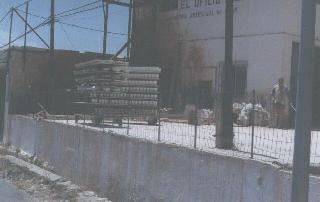 'Alfarería El Oficio', Níjar, Almería
'Alfarería El Oficio', Níjar, AlmeríaThis is a typical pottery in the street of Las Eras. Pots on long boards are loaded on a cart to dry in the sun.
In June 1997 I re-visited the Andalusian village of Níjar after eight years of absence. I used to live in Níjar and my three children grew up there. Their primary education took place in the fairly modern school in the newest part of the village. For fifteen years I lived amongst the local inhabitants and shared much of their way of life. I used to watch the local potters at their work, for potting was the main 'industry' there. It was a tradition handed down from father to son and mother to daughter, dating back to the times of the Arab occupation of the region. The men spent all day at the wheel from the age of ten when they were first apprenticed. Their wives and daughters sat on low straight-backed chairs decorating the recently thrown greenware after a preliminary drying out in the hot sun. The clay was locally dug; a mixture of two different types. The end result was a tan-coloured body with a fairly high iron oxide content and good resistance to thermal shock. The ware was dipped in a creamy mixture of kaolin and water before being slip-decorated with kaolin and iron, cobalt, copper or manganese. More frequently the slip was brushed on in haphazard patterns, but some of the more skilled women would trail more complex designs using a simple tin can with a hole in the bottom to distribute the slip. Once the design was complete, the ware was dipped in a raw lead glaze of the most toxic type - galena. Once a month the great wood-fired kilns were stacked with hundreds of pieces and fired for long hours in an atmosphere which varied between oxidation and light reduction. No pyrometers were used and a temperature of about 1000C was usually reached. The ware was stacked tightly into the kiln, earthenware tripods were used to separate each piece, forming carefully balanced stacks of plates, bowls, pitchers and ashtrays. These simple tripods would be removed from the fired ware with the sharp tap of a hammer, leaving a distinctive scar on all but the top piece of a stack. The result was a very primitive, somewhat heavy kind of pottery, with warm colours ranging from iron yellow to reddish brown, copper green and manganese egg-plant purple on a background of mellow kaolin white. The raised slip-trailed designs were particularly attractive. This pottery, although supposedly very toxic, was used for centuries by the locals in their kitchens without any apparent ill effects. They would first 'cure' many of the pots by filling them with a solution of wine vinegar and water and cooking them in the domestic oven for an hour or two. According to them, this would free the lead content and make the ware foodsafe. The pots from Níjar were well-known throughout Spain as well as being sought out by foreign tourists from the rest of Europe who would buy them as decorative items rather than for practical usage. The potters themselves were vaguely aware of the dangers of lead-poisoning and would keep both cats and canaries in their workshops, believing that these would be the first to succumb in the event of an overdose of lead dust in the atmosphere. When I first went to live in Níjar in 1974, there were about half a dozen potting families, several of whose members were inter-related. They all had their workshops in the same narrow street and some had adjoining showroom-stores. Potting was a way of life in the village and had changed very little over the centuries.
 'Alfarería El Oficio', Níjar, Almería
'Alfarería El Oficio', Níjar, Almería
This is a typical pottery in the street of Las Eras. Pots on long boards are loaded on a cart to dry in the sun.
And so I when I returned to Níjar for a short visit in June 1997, I expected to find the potteries unchanged. The potters would be older, sons would have taken over the wheel from their fathers, daughters would be decorating the ware in the traditional way, the kilns would belch their monthly columns of smoke into the clear blue sky overhead. The canaries would be singing in their cages on the wall above the barrels of galena glaze.